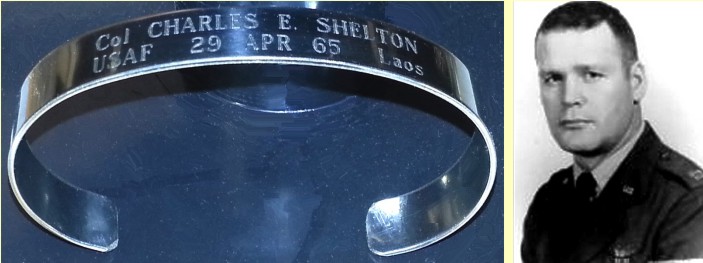
Left: Bracelet; right: Shelton photo (Vietnam Veterans Memorial Fund website www.vvmf.org).
Comments? [email protected].
Earlier columns from 2014 may be found at: 2014 Index.
Links to previous years are on the home page: Home
Kansas Snapshots by Gloria Freeland - March 28, 2014
Treasure hunt
It seems that through much of our lives, we are collectors. We gain knowledge, we gain friends and we gain things. Yes, we lose some too, but the net result is positive.
Then we reach a time when that begins to reverse. Some of it is unintended and unwanted, such as losing parents and loved ones or forgetting where we set our keys. But slowly, we begin to intentionally collect less and let go of more.
I thought of this as I went through my jewelry drawer last week, trying to decide what to let go of and to organize what I'd keep. But soon "treasures" I'd long forgotten began to surface.
Some had both intrinsic value and value as a keepsake. These included my grandmother's tiny gold ring; a lapis lazuli necklace late husband Jerome bought me in Mexico; a filigreed silver bracelet with tiny Chinese figures that Uncle Bud gave Mom when he was stationed in China during World War II.
Most only had special significance to me. There was my grandmother's gold thimble; a blue plastic rosary given to me by a young nun who helped care for my family in the hospital after our head-on car crash 50 years ago; a mustard seed necklace Mom and Dad gave me when I married husband Art in 1988; a glass heart on a gold cord given to me by daughter Mariya when she was just a girl; a Bolivian necklace made of volcanic rock and large green stones sister Gaila gave me; a watch Grandpa and Grandma Freeland had given Uncle Stan during World War II; and so on.
Another made me smile. It was a small box with a Christmas gift tag from daughter Katie. On the outside tag was "To Mommy/ From Katherine" in childish script. Inside was a gold ring she had found, along with a note: "Dear Mommy. I'm only giveing you one present this year because one of your gifts broke. So I hope you understand. Love Katherine."
But what I found that surprised me the most was a metal bracelet inscribed: Col. Charles E. Shelton/USAF/29 Apr 65/Laos.
I remember buying a Prisoner of War/Missing in Action (POW/MIA) bracelet during my college days in the 1970s, but I'm not sure what happened to it. I don't recall for sure, but I think I bought this particular one in the early 1980s on a trip to Washington, D.C. It promptly went into my jewelry drawer where I would occasionally look at it and wonder what happened to "my" POW, and then just as quickly, forget it.
I decided now was the time to answer that question that had so often surfaced, and then as quickly vanished.
I learned from an Internet search that on April 29, 1965, Shelton was flying a photography mission over Laos. Since the area was considered safe, it didn't count as one of the missions that he needed to be sent home. He was searching for caves that might be used as hiding places for men and supplies. It was his 33rd birthday.
Just as he was about to fly over the assigned area, his plane erupted in flames, probably hit by enemy fire. He ejected and parachuted to the ground.
He stayed in radio contact with two rescue planes, but their search was delayed because of bad weather. By May 2, Shelton was nowhere to be found. The search was called off May 5, and Shelton was listed as "Missing in Action, believed captured."
Although there were reports of Shelton being seen alive in Laotian or Vietnamese prisons over the next few years, the trail eventually went cold. He was promoted to the rank of colonel during this time.
For 25 years, his wife Dorothy tried to find out what had happened to her husband, but without success. From time to time, stories emerged from the jungles of Southeast Asia from people who were sure they had seen Shelton. Several rescue missions were launched, but those that reached their intended targets found no trace of the pilot.
The strain of rising and falling hope took a toll on her, according to her family. She took her own life in 1990 and was buried next to her husband's empty grave in Arlington National Cemetery.
In 1994, the five Shelton children decided it was time to put the past behind them. For 29 years, Shelton had been the only Prisoner of War who was not declared dead by the U.S. government. He had been selected to be the "face" of an MIA. In that role, he had served as the symbol for all those whose fates had never been resolved and so he served as encouragement to others who might be able to help in the search for any MIAs. The children asked the Air Force to reconsider their father's status. He was reclassified as Killed in Action.
Four years after their mother's death, Col. Charles E. Shelton's name was placed on a tombstone at Arlington. He was also honored on Panel 1E, Row 111 of the Vietnam Veterans Memorial in Washington, D.C. and at the Charles E. Shelton Freedom Memorial on the river front in his hometown of Owensboro, Ky.
When I had finished sorting through the items in my jewelry drawer, each item that remained told a "story" about my life or was connected to the life of a family member. Except one.

Left: Bracelet; right: Shelton photo (Vietnam Veterans Memorial Fund website www.vvmf.org).
Comments? [email protected].
Earlier columns from 2014 may be found at: 2014 Index.
Links to previous years are on the home page: Home